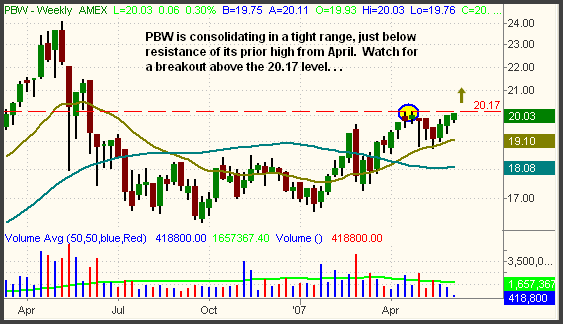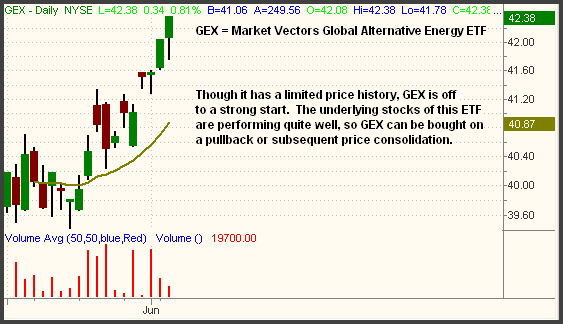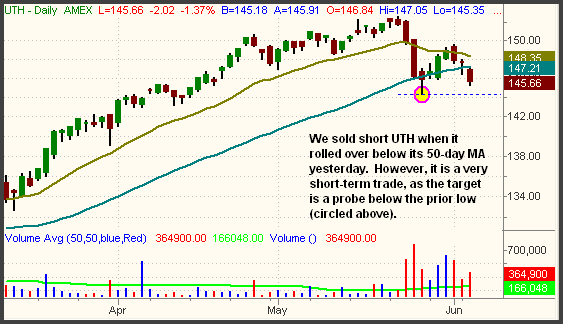|
The Wagner Daily ETF Report for June 6
A moderate round of institutional selling triggered a broad-based correction yesterday, but a late afternoon bounce helped reduce the stock market's losses. The Nasdaq Composite, down as much as 0.9% at mid-day, finished the session only 0.3% lower. The S&P 500 and Dow Jones Industrial Average fell 0.5% and 0.6% respectively. The small-cap Russell 2000 lost 0.8%, while the S&P Midcap 400 slipped 0.6%. Each of the major indices except the Nasdaq closed just below the middle of its intraday low. The Nasdaq settled near its high. Internets ($GIN) and Networking ($NWX), the only two major industry sectors that advanced yesterday, helped the Nasdaq to show its relative strength.
Volume picked up across the board, causing both the S&P and Nasdaq to register bearish "distribution days." Total volume in the NYSE increased by 12%, while volume in the Nasdaq came in 14% above the previous day's level. Though it's negative when the market declines on higher volume, an occasional bout of institutional selling is normal within the context of a steady uptrend. For the S&P and Dow, it was only the second such "distribution day" in recent weeks. Prior to last week, the Nasdaq had been lagging behind the other major indices. As such, the index has also flashed more days of institutional selling. There have been six "distribution days" in the Nasdaq since the beginning of May. Declining volume in the Nasdaq rivaled advancing volume by a margin of 2 to 1, which wasn't that ugly. The NYSE ratio was negative by just over 3 to 1.
Alternative energy stocks, specifically those related to solar power, were among the day's largest gainers yesterday. SunPower Corporation (SPWR), a leader in the solar arena, surged 6.0% on stronger than average volume. First Solar Inc. (FSLR), another major player in the field, rushed 4.5% higher. Since February of this year, solar energy stocks have scored impressive overall gains. FSLR, for example, has more than doubled within the past four months. Although we have been profiting from solar stocks in our hedge fund, we have not discussed the sector in this newsletter due to the lack of a directly correlated ETF. The solar energy sector is still too small to have its own specialized ETF, but there are several alternative energy ETFs that offer exposure to the solar sector.
Launched in March of 2005, PowerShares WilderHill Clean Energy (PBW) is the "oldest" exchange traded fund comprised solely of alternative energy stocks. Its holdings are U.S.-based companies, primarily small and mid-cap, that are in some way engaged in the production of "clean" energy. Wind and solar-related stocks are key holdings of this ETF. Both SPWR and FSLR are among the top 10 holdings in PBW, each one having an approximate portfolio weighting of 3.5%. On a technical basis, PBW had a strong rally in the first half of 2006, peaked in May of that year, pulled back for the next two months, then finished the year in a sideways range. Recently, PBW has begun to show renewed signs of life. As you can see on the weekly chart below, its range has tightened up as it consolidates near its 52-week high:

PBW finished yesterday just below its 52-week high of 20.17, which was set on April 25, 2007. With its recent tightening of consolidation, it looks as though PBW will soon break out above this level. Note that PBW is a low-volatility ETF, so increased share size may be necessary if trading or investing in it.
A newer player to the alternative energy ETF market is the Market Vectors Global Alternative Energy (GEX). Comprised of just thirty stocks, GEX differs significantly from the composition of PBW. The biggest difference is that only 40% of the underlying assets in GEX are American companies. The majority of its assets are from European companies, with about 7% Chinese thrown in for good measure. Conversely, PBW is comprised solely of American companies. 49% of the holdings in GEX are mid-cap companies, 20% are large-cap, and 31% are small-cap. PBW, on the other hand, has practically no exposure to large-cap stocks. GEX has a limited price history, but has been trending steadily higher since it came to market just one month ago. Over the past two sessions alone, GEX has gained 2.0%. That compares to a 0.3% loss in the S&P 500 and a flat Nasdaq during the same period. Below is a daily chart of GEX:

The relative strength of GEX over the past week makes it one of the strongest ETFs in at least the short-term. We're currently stalking GEX for a potential buy entry point, either on a pullback or subsequent price consolidation. Solar stocks such as SPWR or FSLR are great if you trade individual stocks, but those who invest only in ETFs will find GEX to be a more diverse, lower-volatility way of participating in not only the solar energy field, but global alternative energy as a whole.
In the June 4 issue of The Wagner Daily, we noted that the Utilities HOLDR (UTH) would likely resume its downward correction if it failed to get back above its 20-day EMA. It subsequently showed relative weakness to the market that day, dipped below its 50-day MA, but recovered to close above it. Yesterday, however, was another story. UTH gapped down to open below its 50-day MA, then promptly slid below the prior day's low. In anticipation of short-term downward momentum, we sold short UTH on the open. The trade is already showing an unrealized gain of more than a point, but we only plan to hold UTH short for no more than a few days, in order to capture short-term downward momentum on the break of the 50-day MA. A probe below support of the May 25 low is our near-term price target:

Despite substantial losses in the Shanghai market over the past week, the iShares Xinhua China 25 (FXI) has ignored the trend. When the Shanghai exchange fell more than 6% on June 4, FXI curiously lost only a few cents. When the Shanghai market recovered a bit of its loss yesterday, it sent FXI more than a point higher and stopped us out. Because FXI is comprised of large-cap stocks, a bit of relative strength would be understandable, but such huge divergence is very unusual.
The Semiconductor Index ($SOX) showed a lot of relative weakness yesterday morning, so we made a judgment call to cancel our original stop and sell our SMH position when it broke support of the 20-day EMA. The trade lost only 20 cents, so it was essentially a scratch. If yesterday's action was just a fluke or "shakeout," we'll be happy to re-enter SMH on a rally above yesterday's high. In addition to UTH short, we remain long FBT. ETFs we are stalking for potential long entry include: DBC, SLV, PBW, and GEX.
Deron Wagner is the Founder and Head Trader of both Morpheus Capital LP, a U.S. hedge fund, and Morpheus Trading Group, a trader education firm launched in 2001 that provides daily technical analysis of the leading ETFs and stocks. For a free trial to the full version of The Wagner Daily or to learn about Wagner's other services, visit MorpheusTrading.com or send an e-mail to deron@morpheustrading.com.
|